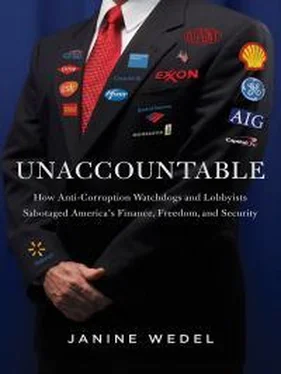As for Transparency International, despite over-focus on its media-friendly CPI, the organization has initiated some useful work on a much broader front. One example is its National Integrity Assessment, a questionnaire that assesses a country’s institutional “pillars,” including business and civil society, as well as the independence of its watchdog institutions. Deployed in many countries, the results of the surveys have sometimes drawn local attention to such issues and resulted in change.
Even though major (especially finance-related) corruption scandals in the developed world of the late 2000s may have tempered the idea of corruption as primarily an affliction of the Other, the idea lives on in the corruption literature.
While the economists did issue some Vatican-style reforms, they mostly did so only within their own narrow framework. Only a handful of renegades, such as the Nobel laureates Joseph Stiglitz and Paul Krugman, began speaking of the United States and “crony capitalism” in the same breath in the 2000s. 103Thus corruption economists continue to perfect the metrics, much like an abused, spurned lover who desperately keeps coming back, seeking to mend the relationship. And the “globalised elite discourse” that Sampson describes “ensures that the issue [of corruption] remains on the agenda . . . even if in revised or ‘new improved’ form ” [emphasis added]. 104
As the anti-corruption industry matured, corruption indices generally became more sophisticated. Eventually—a decade after Lambsdorff pioneered TI’s Corruption Perceptions Index—critique of the metrics-as-analysis approach came from within the economics profession itself. 105And, at this writing, the endeavor has come to embrace scholars from different disciplines and those with real-world experience in a variety of settings. 106
Yet despite fresh ideas about what corruption is and does, corruption-ranking indices are still de rigueur in the industry, even if many inside have abandoned the creed and even if the faith placed in them far outstrips their analytic value. Much like under late communism, the ritual has to be preserved. As one scholar writes: 107
While it is widely recognized that performance indices in this area suffer from severe methodological problems regarding precision and reliability, they nevertheless seem to co-exist with a deep-seated belief in the powerful factuality of numbers, measurement and comparison, just as they play an important role as a reference point for standards and scripts for action.
More crucially and tellingly, the anti-corruption industry has kept and even expanded its PR tools—the CPI and other metrics—despite alarm from inside and out about their serious defects. The industry won’t give them up, ostensibly because much media attention would dissolve without them. And that attention is a must for getting policy done, as explained in an article by a political scientist titled “The Power of Performance Indices in the Global Politics of Anti-Corruption.” 108The “performances” that are the release of the CPI have become an anticipated necessity, some scholars argue. 109And, as we shall see in the next chapter, “performance” is not to be overlooked.

The economists’ crusade and the strange bedfellows at the Washington conference were just a taste of what was to come in 2008—and with well-known global impact. While the economists loosed their hubris on much of the world when the United States was riding high, the fruits of that hubris were about to circle back. And while the public trust was being violated by members of their profession, they reduced complex realities to single numbers, applied ill-suited theories, and misled us with inaccurate metaphors. This is not to say that they were necessarily conscious of their own myopia or that they are personally to blame. It is to say that the rest of us need to be all the more attuned to the power and prowess of a religion whose High Priests have invited so much unaccountability.
Finally, it is to say that we need to learn to discern the performances of the High Priests and their ilk and to look underneath the surface of performances, be they numbers, players, or the media—the subject of the next chapter.
CHAPTER 5
Privatizing Media, Performing “Truth”
If you can’t trust your pornography, what can you trust?
It may seem preposterous to open a chapter on the public trust in the media and Internet—and what this means for accountability—by linking the words “pornography” and “trust.”
And yet a sea change in the porn business illuminates much about our culture, our flagging faith in public institutions, and our retreat to the private realm in search of truth—and what passes for both private and truth.
Porn stars, we know, are actors. But the quest for (true) reality runs so deep that it is seen even in pornography, that land of artificial desire and silicone dreams, where everything is, almost by definition, a performance. It used to be that porn came in a brown wrapper or in an “adult” shop peepshow or a video made in southern California, the center of the (American) industry. But that porn provider is being edged out by the housewife in Omaha who might appear headless, performing self-sex, in her own posted video. Or by live ladies for whom you might pay up, then chat with online. In the past, there was little denial that porn stars were acting. In fact, an anthropologist who studies porn culture has discovered that these days, one of the most compelling selling points in online porn is that what you are seeing is “real,” performed by supposed “amateurs.” 1
Apparently, we so crave authenticity that we look for it even in an entertainment genre that is, well, staged.
Nowadays, the Internet enables us to cut out the middleman and fully indulge our tastes in a customized fashion. The modus operandi is DIY—do it yourself—for both providers and consumers. Practically anyone can become an online mom-and-pop porn proprietor, and the options transcend borders with ease. In one sitting, you can skip from the Midwestern headless housewife and go to Yukiko the Asian dancer and then to clips of Natasha, the Ukrainian blonde who supposedly just turned eighteen. A search for the word “real” might bring up a dozen categories on an online porn site: “real couples,” “real homemade,” “real teenager,” “real orgasm.” If you want to get “really real,” so to speak, you might pay a premium for a live chat or personalized show, but a huge amount of material is now entirely free. And you can watch in the privacy of your own home (your choices being recorded only by your Internet provider and the NSA, as far as we know). We have sent the traditional porn industry into a tailspin, but this is just the most sensational part of our media culture that has been upended by the Internet. 2
The sea change in porn might seem to be of little consequence to those who don’t indulge in it. And yet it pulls back the curtain on the personalization of the media and Internet and why today’s top power brokers, clothed as they are, can operate willy-nilly beyond accountability—and get away with it. Unlike with other arenas like finance or health care or national-security policy, however, we, the public, can hardly make a convincing case that the sweeping changes in the media just happened without our complicity. We have been, and are, ever-more-active participants in sowing this unaccountability.
Moreover, the media and Internet spill back into and drive just about every arena of public life, building themselves into their very essence. That’s why I devote an entire chapter to how changes brought about by the digital age have completely reconfigured the mass communication industry that is now not just media, but a new creature: media/Internet. That creature enables power brokers to operate beyond accountability in ways never before possible and amounts to a wholesale societal and cultural shift. While practically every organization is now a beacon of “transparency,” including the NSA (see its website and peruse its “commitment” and “dedication” pages 3), ironically, just where “information” comes from and what agendas might be behind it is often less transparent than ever before in living memory.
Читать дальше













